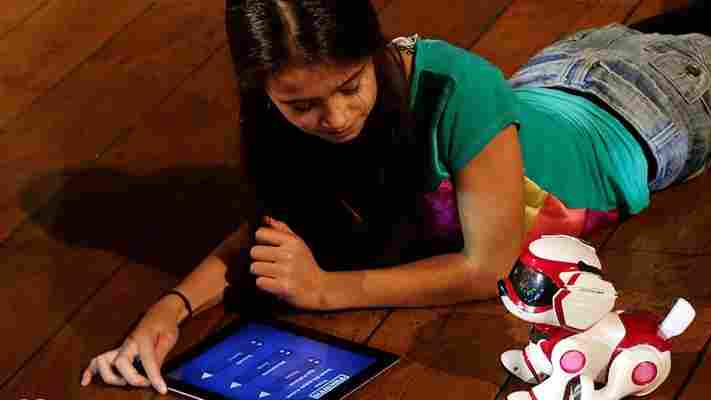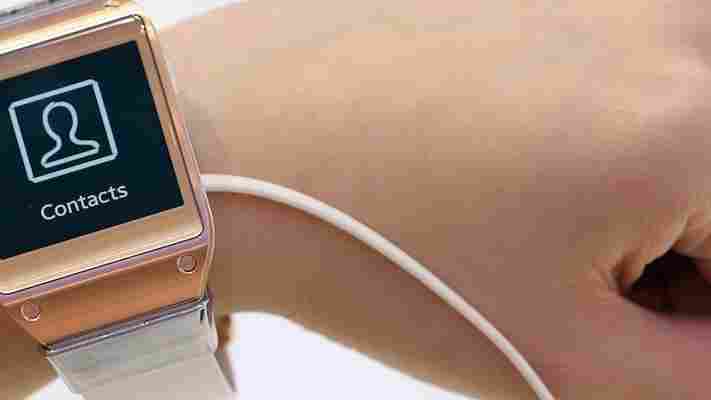Can children as young as five years old start learning programming?

Vikas Gupta, the co-founder and CEO of Play-i , thinks so. And this is why he has started on a journey to create two robots called Bo and Yana.
Along with the robots, there’s a visual programming environment created on touch devices for kids, which meets the children’s level of cognitive ability and motor skills, starting as early as age five and extending to beyond 12 years old.
The journey is just beginning, as Play-i recently raised $1.44 million through a crowdfunding campaign that lasted one month, with orders placed for 10,994 robots. The company started off with a funding goal of only $250,000 — which it hit in a mere three days .
Unlike other programming languages where children are first taught the syntax, Play-i focuses on learning through exploration, play and discovery.
Former Googler Gupta left his job as Head of Consumer Payments at the search giant in 2012, and spent some time with his daughter, who was then one year old. He was inspired by his daughter and subsequently, a report he read about Estonia, which launched a nationwide scheme to teach their first-graders programming. He tells TNW:
Gupta realized there isn’t such a product for young kids that exists in the market, as similar programming robots only targeted older kids from age 11 onwards.
Despite the huge gap in the market though, Gupta admits he was “surprised” that they eventually managed to raise close to $1.5 million worth of funding. When asked why Bo and Yana have turned out so popular, he explains:
For now, Bo costs $169 while Yana costs $59 — but once the robots are widely available for purchase, they will cost more.
Play-i has also consciously emphasized the hands-on aspect of Bo and Yana. Kids don’t have to sit in front of a computer and face an application that teaches programming — they can play with the robots instead.
Furthermore, given the widespread use of touchscreen devices among kids nowadays, parents are probably appreciative of the fact that these tablets can teach a skill instead of just being channels for playing games and watching videos. Bo and Yana connect wirelessly with mobile devices through Bluetooth 4.0, and all you have to do is start the app. Currently Play-i’s visual programming interface works with a series of Apple devices including the iPhone 5 and iPad Air, and the team is working to make it compatible with a larger range of Android devices, as currently those that support Bluetooth 4.0 are very limited.
Other than the US and Europe, Silicon Valley-based Play-i is also shipping to parts of Asia — namely India, Japan, Taiwan and Singapore.
Bo and Yana will reach customers by summer next year, and Gupta says the team is working towards meeting the deadline, as primarily the funding raised will be used to set up manufacturing facilities and kick off production. Manufacturing will be done in China — and Gupta says the greatest challenge of creating Bo and Yana isn’t in hardware, but making sure the software is top-notch.
Ultimately, Gupta’s aim is to make Bo and Yana available to people everywhere — which could be especially important in emerging markets, considering the affordability of the robots.
Gupta notes that the amazing thing about Bo and Yana is they could only have been possible today, given the rapid amount of technological progress made over the past few years. He says:
Headline image via Matthew Lloyd/Getty Images
Samsung’s Galaxy Gear smartwatch is now compatible with Galaxy S4, S3, Note 2 and others
When Samsung launched its Galaxy Gear smartwatch last month, it could only work with the Note 3 and Note 10.1. The Korean company announced today that the Galaxy Gear will be compatible with more devices including the Galaxy S4, S3 as well as Note 2, after a software update to Android 4.3.

It seems like Galaxy S4 owners in Germany can already use the Galaxy Gear with their mobile phone, as Samsung notes that the software update first landed on Galaxy S4 in the European country this month.
The Galaxy Gear will be compatible with more Galaxy devices — including the Galaxy S4 mini, S4 Active, Mega 5.8, Mega 6.3, and S4 Zoom — via a separate software update that will kick in at the end of October, though the schedules for software updates will vary by device, country and carrier.
Image via Samsung, headline image via Sean Gallup/ Getty Images
Flyfit’s fitness band attaches to your ankle for more accurate activity tracking
Tracking your fitness activity is all the rage nowadays, but where most apps or devices rely on monitoring for movement via a mobile phone or a wristband, Flyfit ‘s device is designed to be worn around your ankle.

The San Francisco-based company is currently looking to raise $90,000 via Kickstarter before March 25 in order to fund the project. At the time of writing, shortly after opening the project to the public, it had reached around $5,000 of that target.
The Flyfit is comprised of the tracking unit itself and a detachable strap for wearing it round your ankle – there are five different color options (white, black, yellow, cyan and fuschia) for the strap too. On the main LED unit, there are three symbols to represent each of the main tracking modes: ‘Daily Activity’ (walking, running, cycling and stair/step-types of fitness), ‘Sleep’ (number of hours, how many times you woke up, quality) and ‘Swim’ (leg strokes). Naturally, it’ll connect up to your phone or tablet to give real-time tracking of your fitness activities.
Right now, there are still early bird editions available on Kickstarter for $89, which includes a Flyfit tracker and two bands in your chosen colors. Expected delivery of the first batch is set for August this year, but you’ll need to add $25 more for shipping outside of the US.
➤ Flyfit [ Kickstarter via TechCrunch ]
Featured Image Credit – CHRISTOPHE SIMON/AFP/ Getty Images
